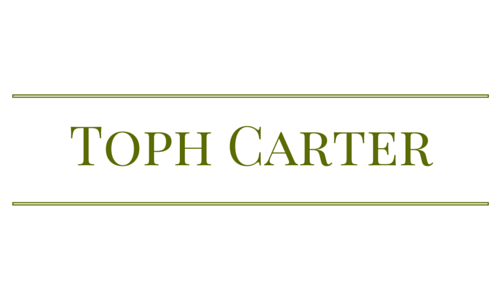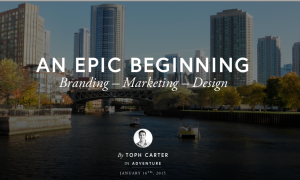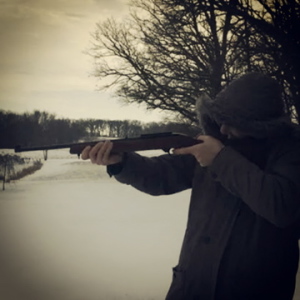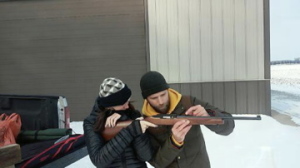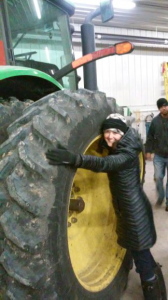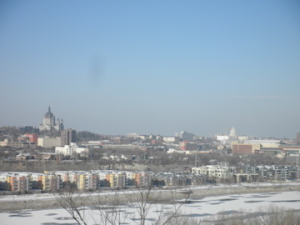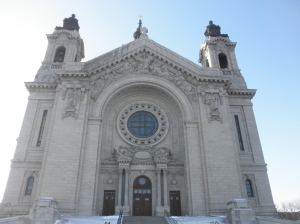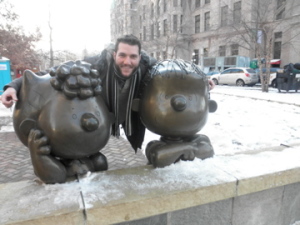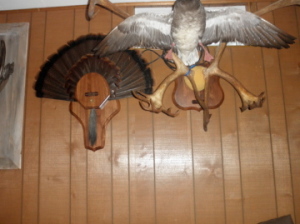
Finding a Diagnosis in Human Centered Design

A dear friend was diagnosed with fibromyalgia. Shortly after she got pregnant, she began having all kinds of chest pains. The doctors told her that it was just the fibromyalgia that was causing the pains. The pains continued. At times they were so sharp she couldn’t breathe and she felt something else was going on. She relentlessly insisted that it was something else with the doctors until they finally gave in and ran more tests. She had a mitral valve prolapse (faulty heart valve), and a blood clot in her right leg. I hate to think what would have happened if she hadn’t been so persistent.
The right diagnosis is critical in a doctor’s office, but is equally important in Human Centered Design. We are working to solve people problems, and without a clear diagnosis we might assign them the wrong treatment. Think of the design solution as the doctor’s prescription to the problem.
As designers, there are several things we can do to make sure that our diagnosis and prescription is on the right track.
Look for Symptoms
It starts with research. Talk to people and listen to their thoughts. Read forums and see what they complain about. Watch how they interact with their environment. Notice what they stress about. Take their temperature, dilate their eyes, and do whatever is necessary to get a clear picture of the problem. While I was working with Soulsight on a project to improve the IKEA Kitchen buying process, we looked for the symptoms/griefs that the user was having. As we documented these findings consistent themes began to appear. These symptoms were the foundation for our diagnosis.
Paint the diagnosis – Keep the problem in front of your eyes
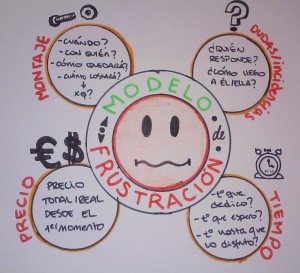 This is one of the major lessons I learned while working at Soulsight on the IKEA Kitchen project. Find images, draw pictures, and make diagrams of the problem. Do anything to make it visual and in front of your eyes continually. With our project, we took the symptoms we discovered through research and drew it on a big paper labeled, “Modelo de Frustracion” Every day when I came to work on the project, I had the user frustrations in front of my eyes; the diagnosis to which I had to find a treatment. This helped us focus on the main problem and not get distracted by extra information.
This is one of the major lessons I learned while working at Soulsight on the IKEA Kitchen project. Find images, draw pictures, and make diagrams of the problem. Do anything to make it visual and in front of your eyes continually. With our project, we took the symptoms we discovered through research and drew it on a big paper labeled, “Modelo de Frustracion” Every day when I came to work on the project, I had the user frustrations in front of my eyes; the diagnosis to which I had to find a treatment. This helped us focus on the main problem and not get distracted by extra information.
Test the Diagnosis
You know when your doctor is 99.9% sure that you have strep throat? You have a fever, can’t swallow, and the rest of your family had it last week, but they STILL test to make sure. As designers we have to do that. We are not God – all knowing and omnipotent. It is possible (aka highly likely) that the initial diagnosis isn’t 100% complete. It is important to test your hypothesis further with users, team members, and professionals. We must continually redefine the problem we are solving. Getting a ‘second opinion’ helps validate and shape our diagnosis. An accurate identification is the first key to a prescription that works to treat the problem.
Treat the Problem, Don’t cover up Symptoms
When people are sick they often treat symptoms. Someone with habitual bad posture would rather take a pill that helps their pain than go through the corrective measures to treat the source of the problem. Sometimes we look for quick solutions to a user’s problems, but that is not our job. The purpose of HCD is to get to the source of a problem and design a solution that makes the life of someone better. Superficial design isn’t lasting design. A way to focus on the problem and not the symptoms is to dig deeper during analysis. During IKEA Kitchen we didn’t stop at Maria wants the someone to quickly answer her questions. We dug deeper –> Maria has major frustrations during the kitchen buying process (Assembly, Price, Time, and Doubts) and deeper –> Maria wants the kitchen to be beautiful and useful from the first day and those frustrations make her worried and deeper –> Maria doesn’t feel safe (that her kitchen turns out well) and valued during the kitchen designing/buying process. When we found the problem we were able to design an effective and lasting solution to help Maria.
Finding and focusing on a clear diagnosis can help us create more effective prescriptions. We get to play doctor as we make people’s lives a little (or a lot-bit) better as we solve complex problems. And the best news: no stethoscope required!
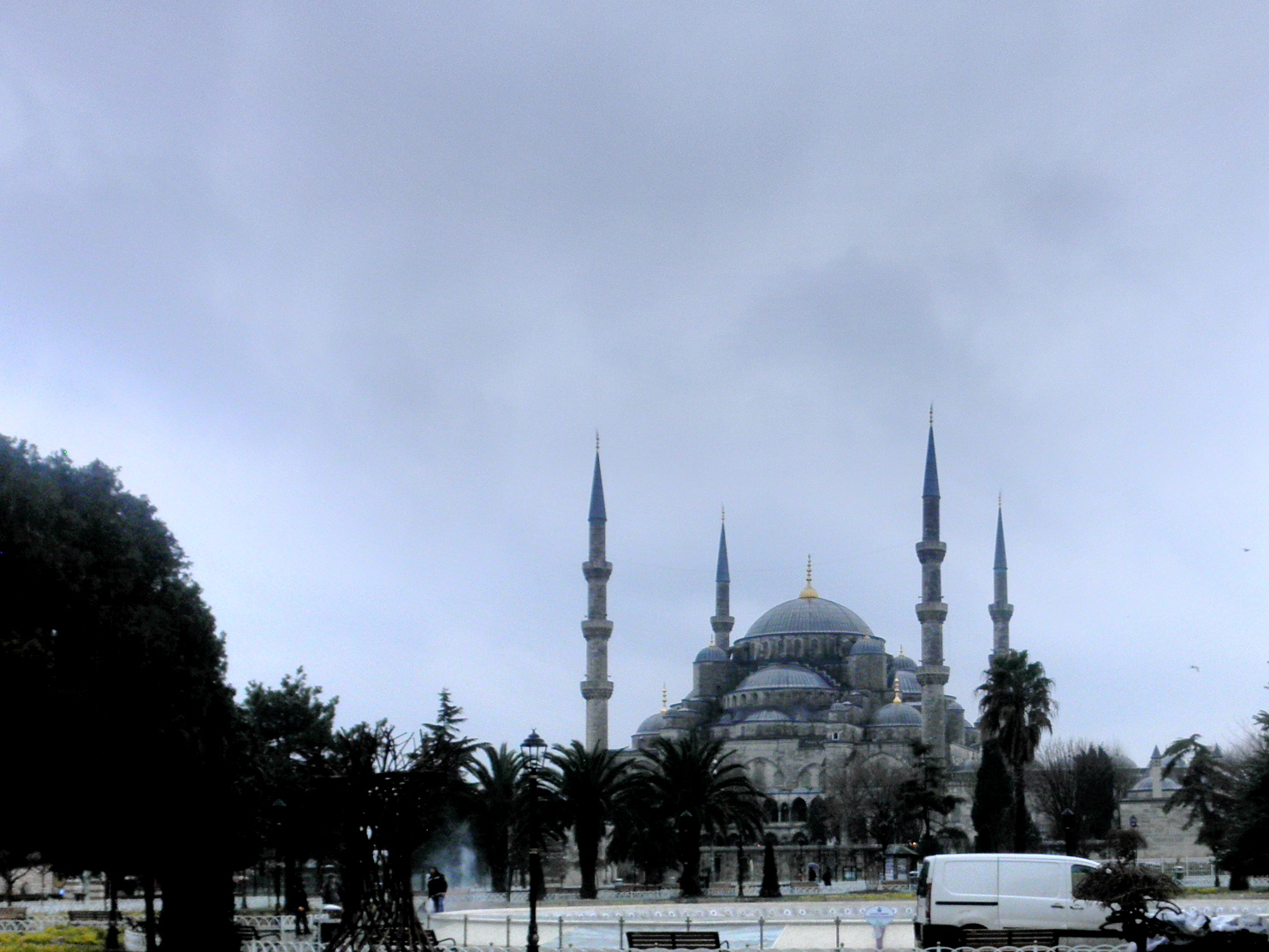
17 hours in Istanbul
This relates my short experience in Istanbul during my layover. It is in two parts. Part 1, Change, was written in the airport while waiting for my phone. It contains my thoughts, perceptions and expectations. Part 2, 17 hours in Istanbul was written after I had returned from the city. Enjoy!
Change
I am dumbfounded by how fast change can happen.
I’m sitting in Turkey’s national airport, Istanbul. This morning I was in Chicago. Hop on a plane and I am now on another continent. It’s like I have stepped into a different world. It’s hard to find people who speak English, my hotel reservations have fallen through, and I am currently paying to have my phone charged. I did get a delicious pastry though.
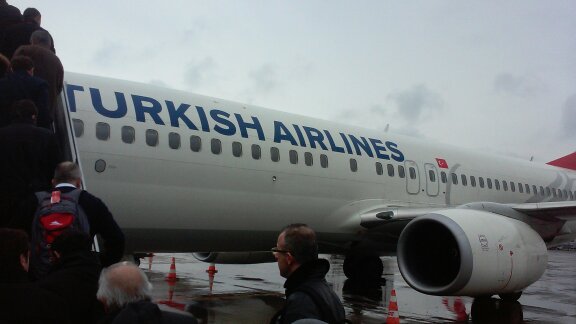
To get into the country I had to pay $30 for a visa. Online it is $20. I hate to think that the precious hours that I have in this amazing city are being spent sitting on a floor typing waiting for my phone to charge.
Looking out, I can envision what this city used to be – an ancient bridge between the orient and europe. The fantastic bazaars are still bustling and the cultural mash that is characteristic of the city is still alive and well.
I just wish I could get out of the airport. All of the signs are in Turkish/English, but I still am having a difficult time navigating – It is all so different.
Turkish airlines might be my new favorite airline. They started the journey with a piece of Turkish Delight. The food was fantastic (seafood) they gave a warm towel, socks, slippers, headphones, a mask, earplugs, toothbrush and anything else I may have needed (including lip balm) The stewardesses were so kind.
But this airport is unsettling. It feels like I am in a different world.
It took me about two hours to figure out where it was that i needed to go to get a hotel. I landed at 4:30 and it is now 7:00.
The clock is ticking and soon I won’t have much time to explore this city.
Hurry up and charge!!
It’s done charging! – but it only charged 10%…. It’ll have to do.
17 hours in Istanbul
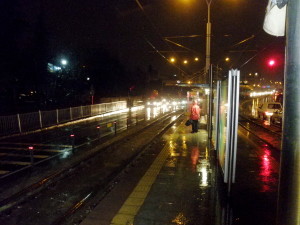
Waiting for the metro to take me to the city
I had 17 hours in Istanbul before I had my connecting flight to Madrid. Who wants to sit in the airport when you are so close to such a historical city!?!
I made it by metro into Sultahmann around 9:00. By this time I had gone on a quest to find an adapter for my phone. (They wanted 60 TL – $30 – for one in the airport. NOPE!). My phone was dead when I hopped off the train.
I was floored. To my right was the Sultahmann Mosque (known as the blue mosque) litup in the night sky. To my left was Hagia Sophia, it’s giant dome and turrets sparkling in the night. I walked and found a storefront selling adapters for 5 TL ($2.50) much better.
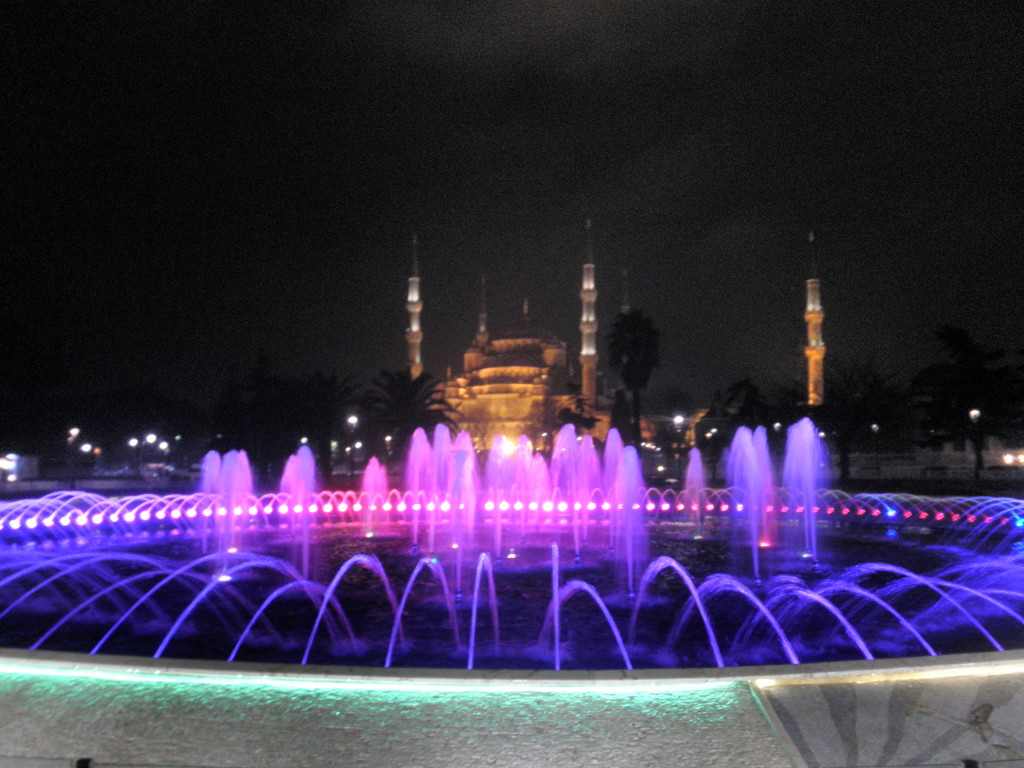
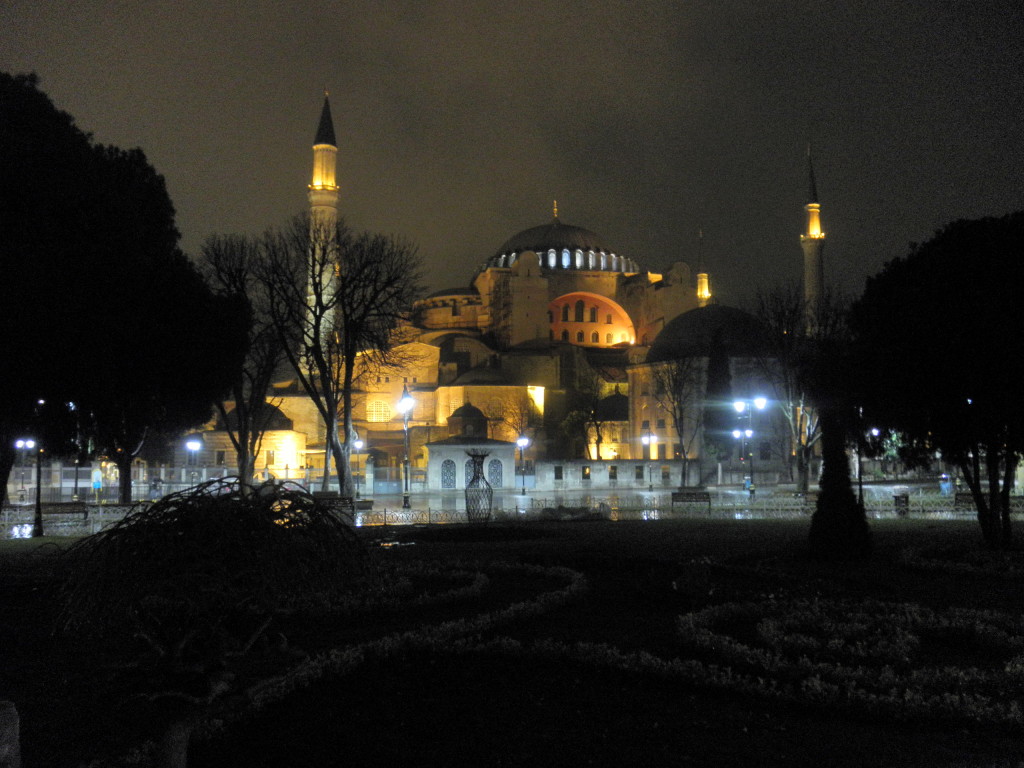
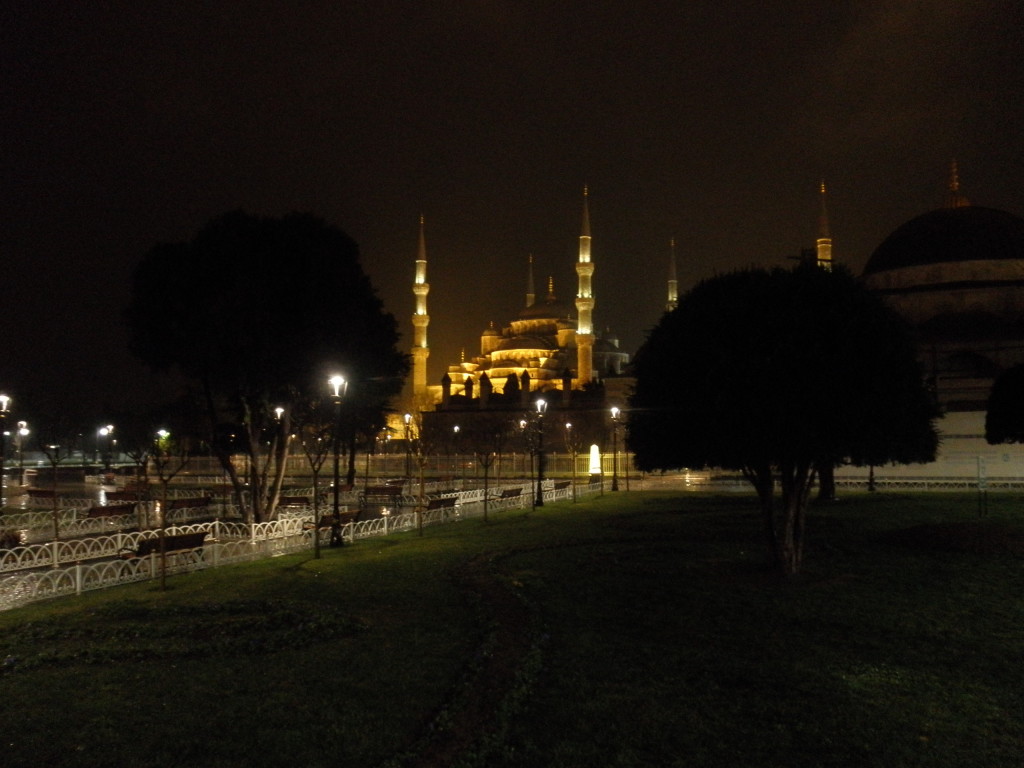
All of the sites were closed because it was later in the evening. I walked around the mosques and down the cobblestone streets. Did I mention it was raining? The whole time. I think I’m permanently damp.
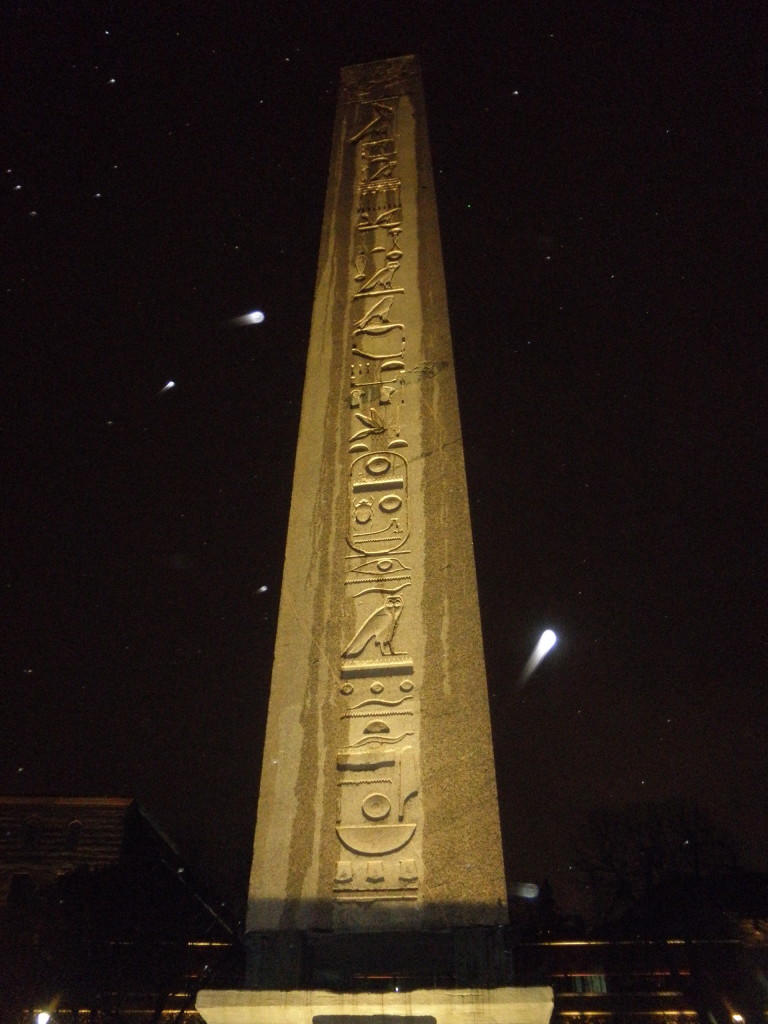
I found an internet cafe and tried to convey to the person at the counter that I didn’t need to buy an adapter, I just needed an outlet. After struggling I had my phone charging and was trying to send an e-mail on the computer to my anxious mother. The keyboard was different, it had three letters that looked like “i”, but none of them would type it. I sent a very misspelled e-mail to my mom letting her know that I wasn’t dead.
It was this time that I decided I didn’t want to sleep at the airport – that I would find a hostel instead. I looked online and found one 2 minutes from where I was at. I scribbled the directions grabbed my phone and headed over. Or at least I thought I did. It wasn’t where it was supposed to be. I wandered for an hour looking for that damn hostel to no avail. It was pouring by this time. I went and spoke to hotel after hotel (there are over 3,000 hotels in istanbul) asking for directions and kept going in circles.
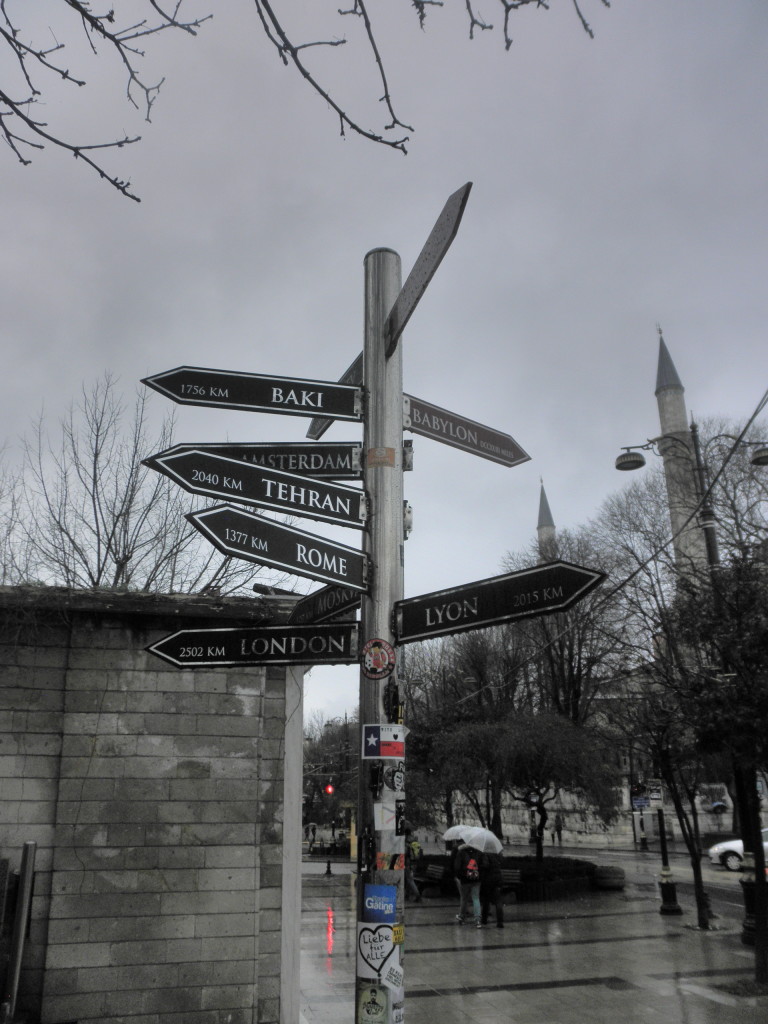
Eventually I ended up in front of 2nd home hostel. It wasn’t the one I was looking for but I thought it was worth a shot – maybe they could help me find where I wanted to go.
I knocked loudly on the front door and someone came to answer. A cat jetted out of the rain and into the room where she joined her kitten. There were several people drinking around lunch tables and I found the person in charge. They told me that I was close and to keep heading the way I was going.
I was sick of running in circles so I asked if they had a bed. They did! I decided that Istanbul Harmony Hostel would be better called the hidden gem of istanbul – so well hidden it is invisible.
I went and dropped my things off on my bed and headed back upstairs to say hello. I met Levi, from Eastern Canada, Hannah, from South Dakota/Amsterdam, and Yusef. They were about to pull the hookah from the corner. That’s not my style, but I stayed to talk. Hannah was interesting (and extremely inebriated). She was talking about how she got hit by a car and because of that settlement she won’t be able to run a marathon – but can travel Europe. She said something about being totally in the present, living life one moment at a time. This is a theme that keeps coming up around me. Mindfulness. taking the time out of the now. Not to worry about the future or dwell on the past – but just breathe and enjoy being.
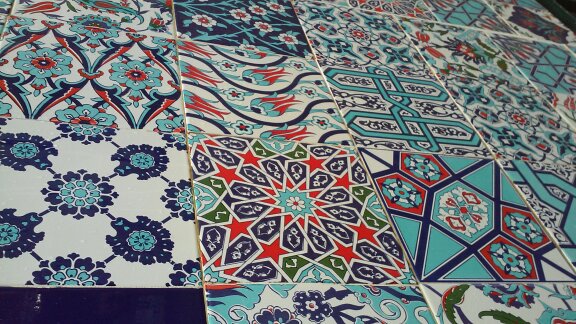
After a quick chat my jet-lagged self was ready for bed. I set my alarm for 7:00 AM, not wanting to miss much of Istanbul.
I slept well until my body decided that 4 AM was enough sleep for me. I heard the muslim call to prayer from my bed – beautiful. It was too early to get up so I chatted with my sisters and dad until the sun peeped it’s head up and then got up and out the door.
I only had 3 hours.
I walked down the street towards the Blue Mosque – I wanted to go inside it. This time the gates were open and I could go into the courtyard. It is incredible. So few things in life make me feel small, but this was one of them. It was still to early to go inside the Mosque so I decided to make my way down to the water. I had spotted it earlier and wanted to at least see it.
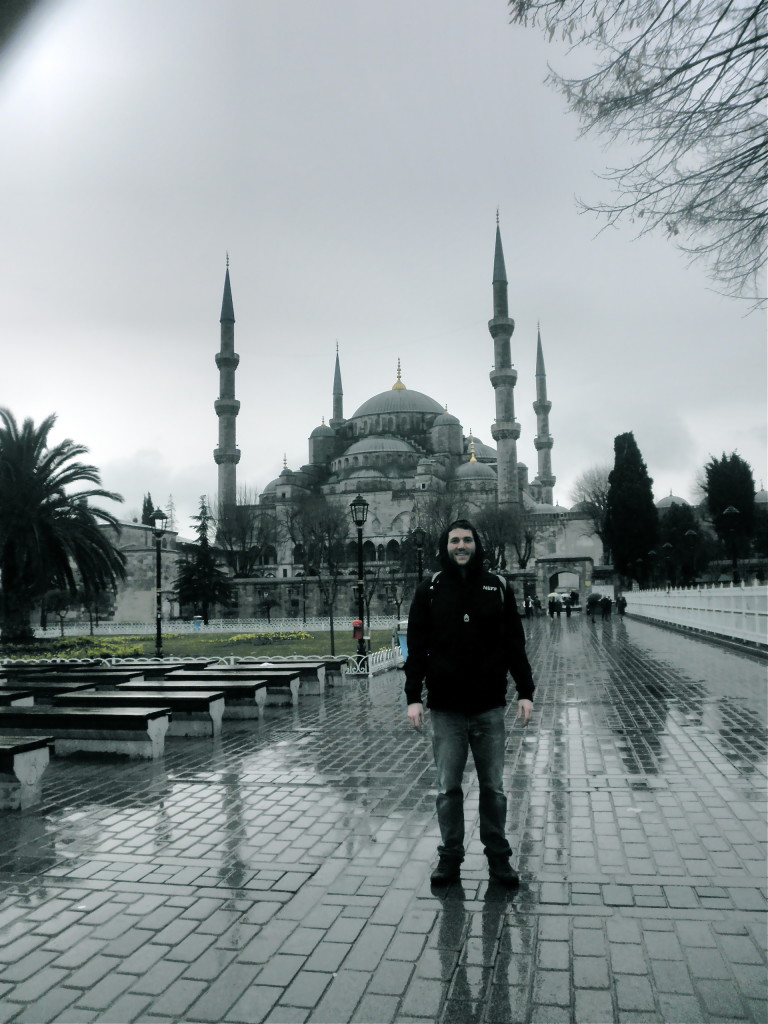
I made it to the ferry dock that was home to 100 resting seabirds. I glanced through the mist and could see the bridge connecting Europe and Asia. I didn’t have time to find and cross it – next time. I wound my way up, past an ancient wall of a castle (from 700 BC) back up to the Blue Mosque. Enough time had passed that I could now go inside. I took off my shoes and wrapped them in a plastic baggie and went through the doors.
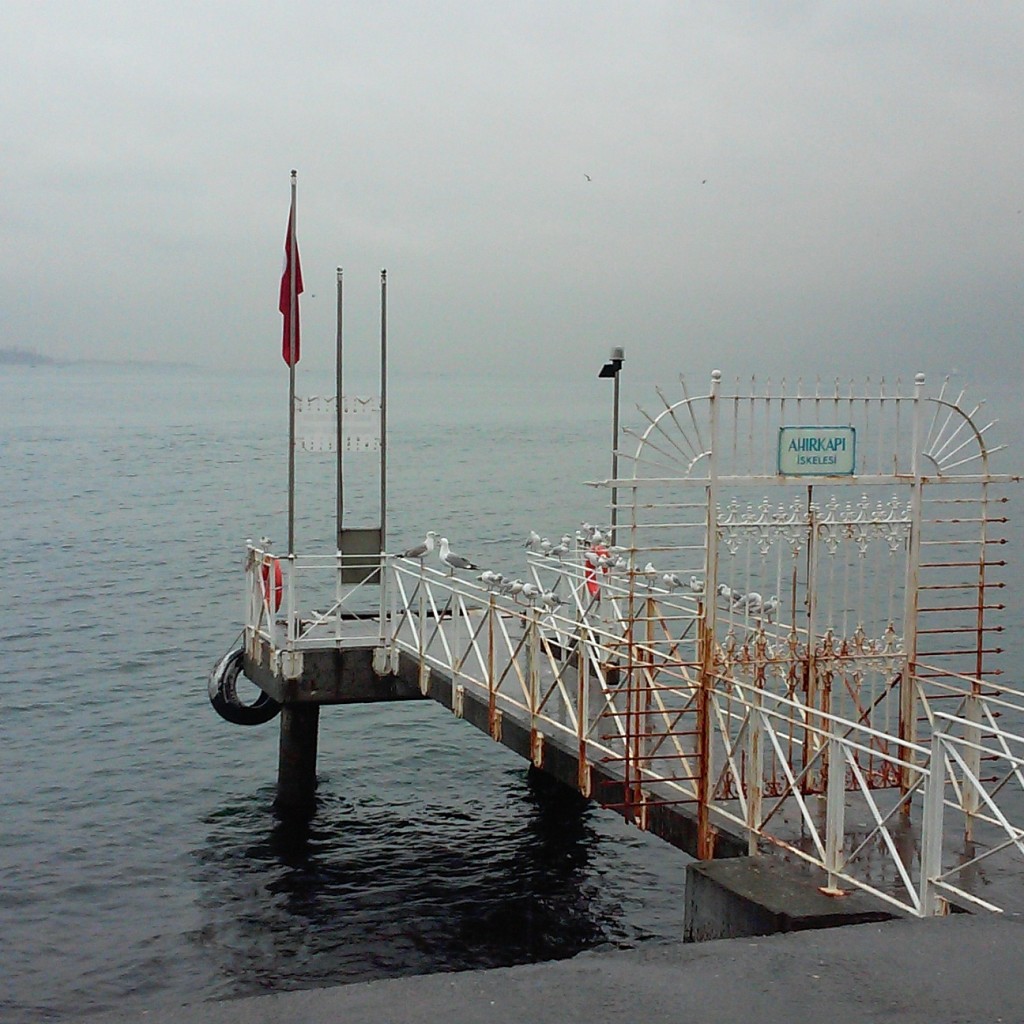
The floor of the mosque was a beautiful soft carpet. Low hanging lanterns were suspended from the ascending walls and arched dome of the mosque. The blue tiles for which it was named) shimmered in the morning light. And there were a lot of tourists with selfie-sticks. In the religion, you are not to make any graven image of God, and so the walls were decorated with beautiful calligraphy instead of images and statues.

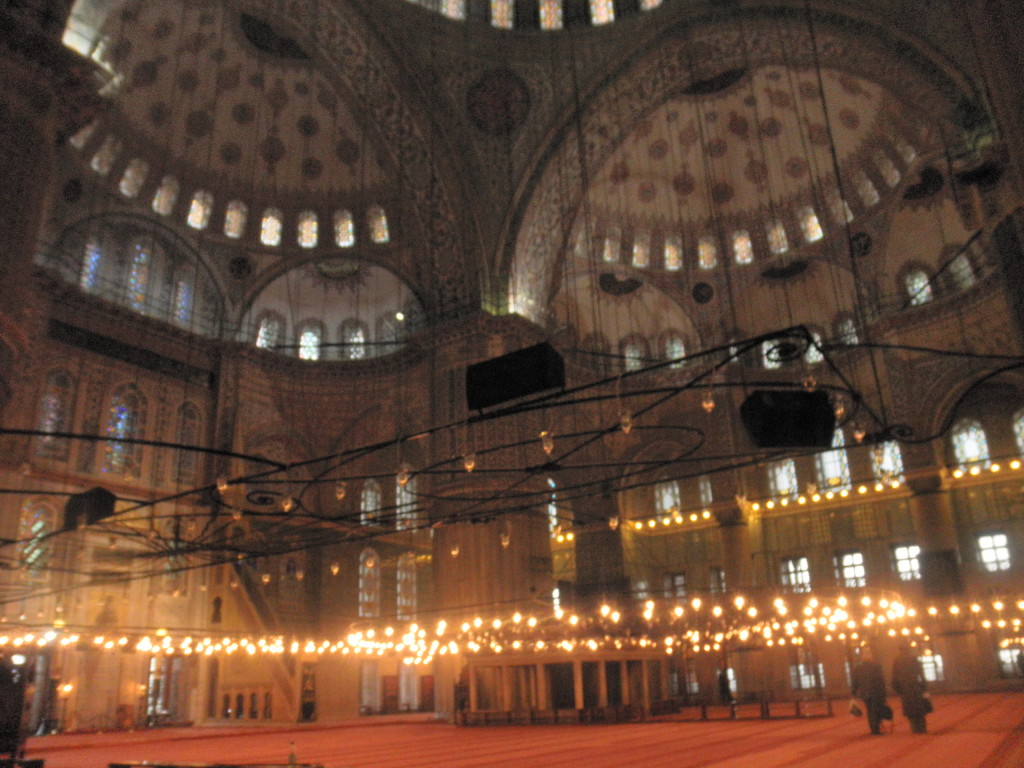
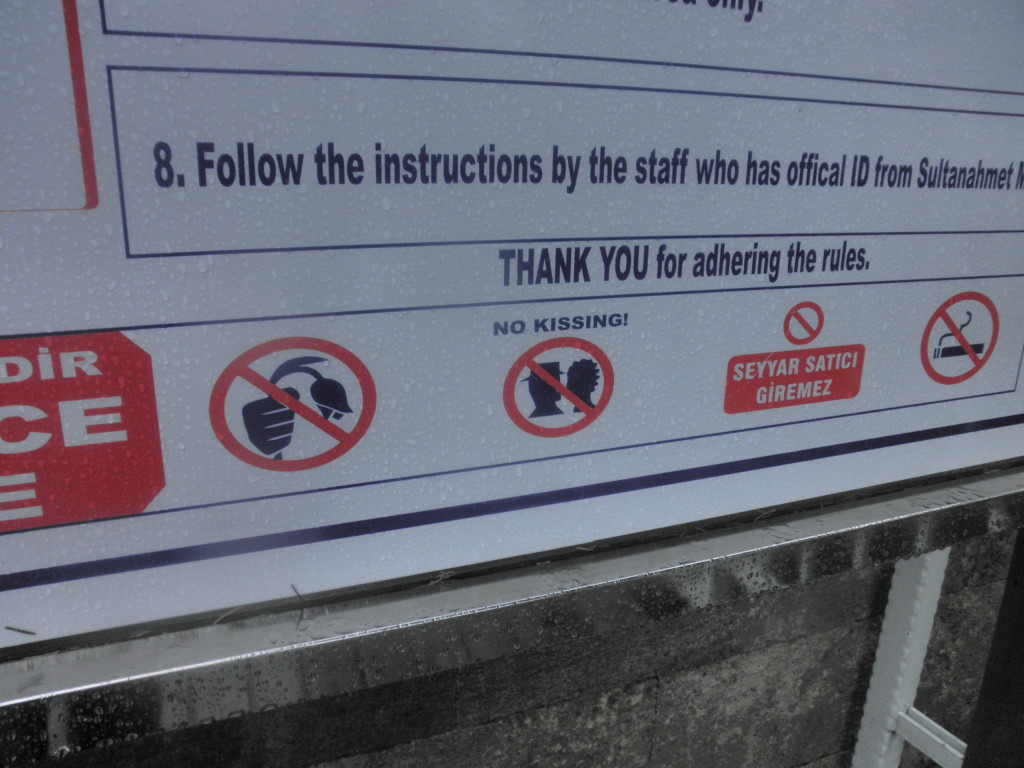
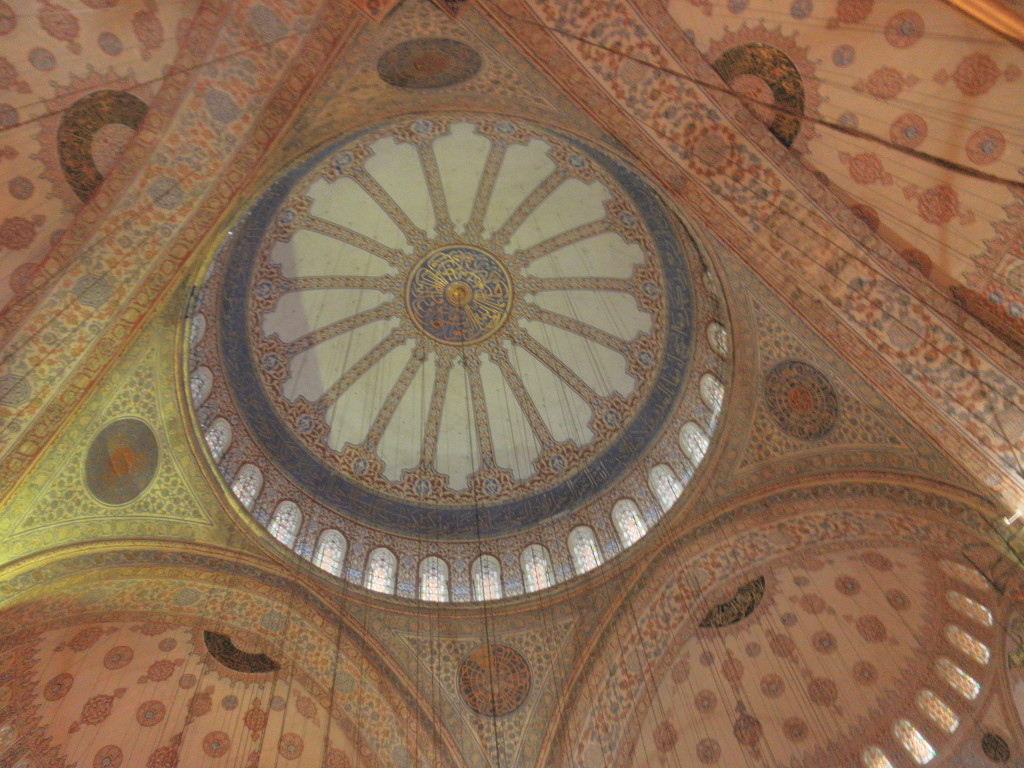
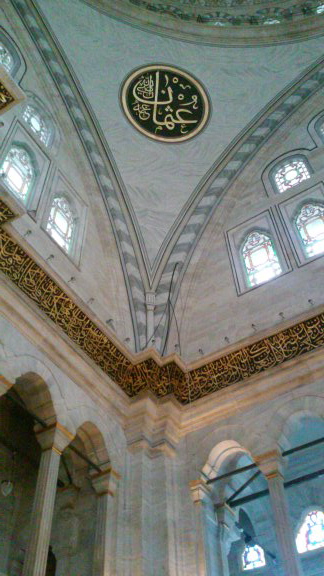
I left and headed to the Grand Bazaar. This indoor marketplace is home to over 4,000 stores, each through winding halls and corridors. It was easy to get lost. The smell was intoxicating as spices were weighed and sold from the racks that seemed to go on forever. Every corner shimmered with silver, gold, antique rugs, tiles, jewelry, and anything else you could imagine. It was bustling. I noticed the care that each shop owner had for their shop. They would often sweep the front of the store, or dust off their precious pieces. I wonder if their fathers had owned the shops before them, and their fathers before that.
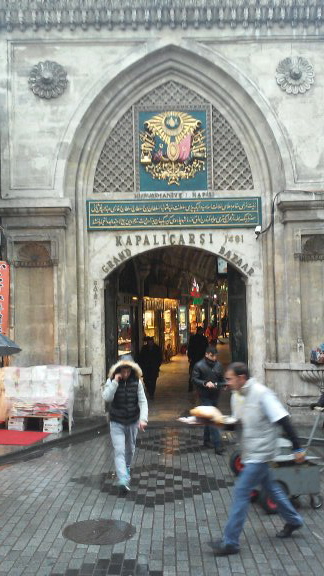
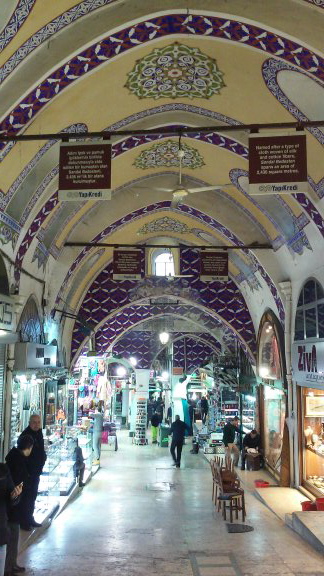
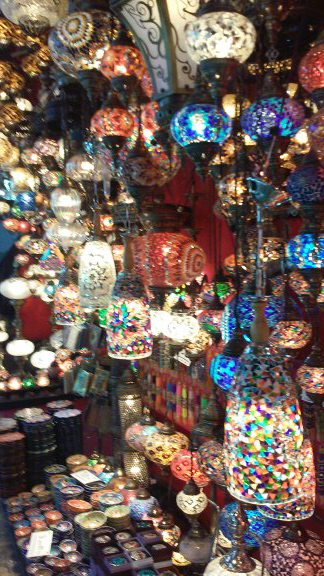
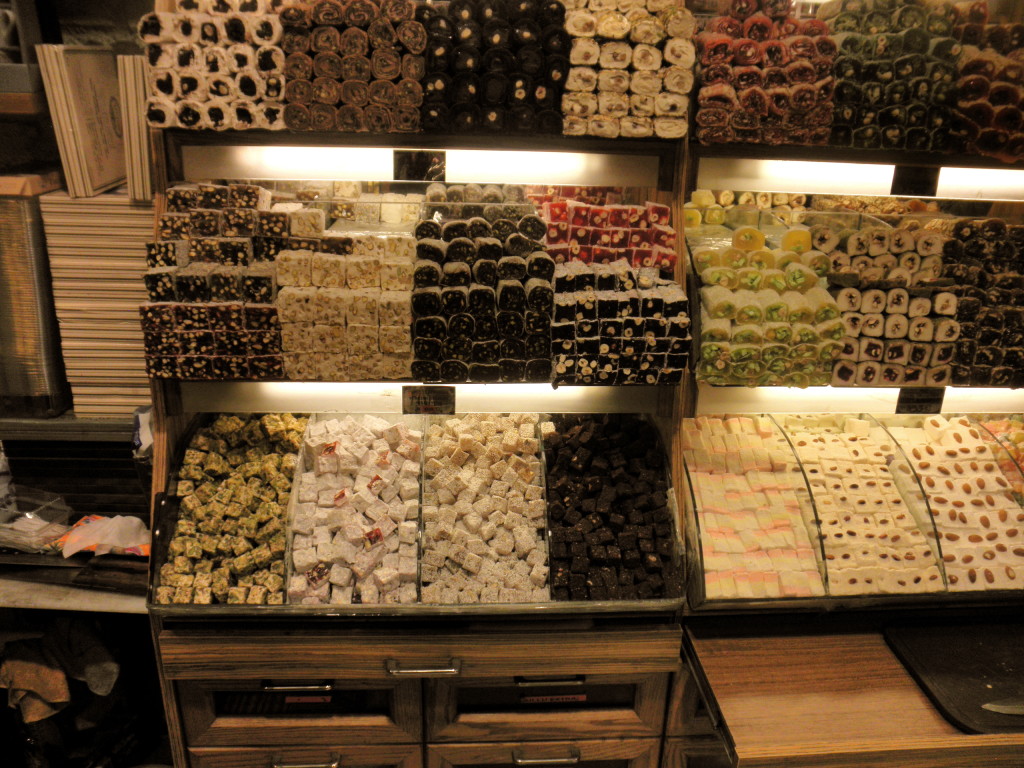
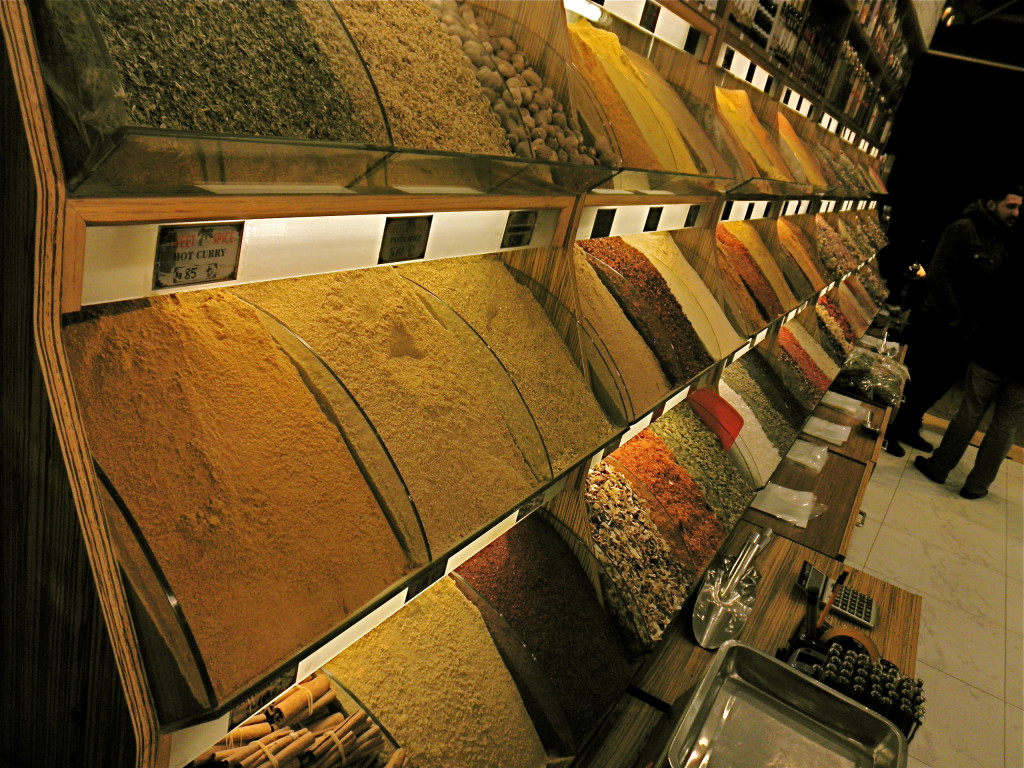
I pulled myself away from the wonder and headed back to the airport. But not before eating some more of the DELICIOUS food. I don’t even know what I had, but it was amazing! I know I had some baklava, and an eggy pastry.. but that’s the extent. The flavors and textures were extravagant.
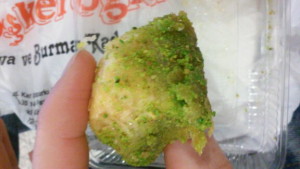
I got back to the airport with plenty of time to board for Madrid. As we flew out of the city, I couldn’t help but think of the surprises I had there. I know I will be back, and this time I’ll come prepared.

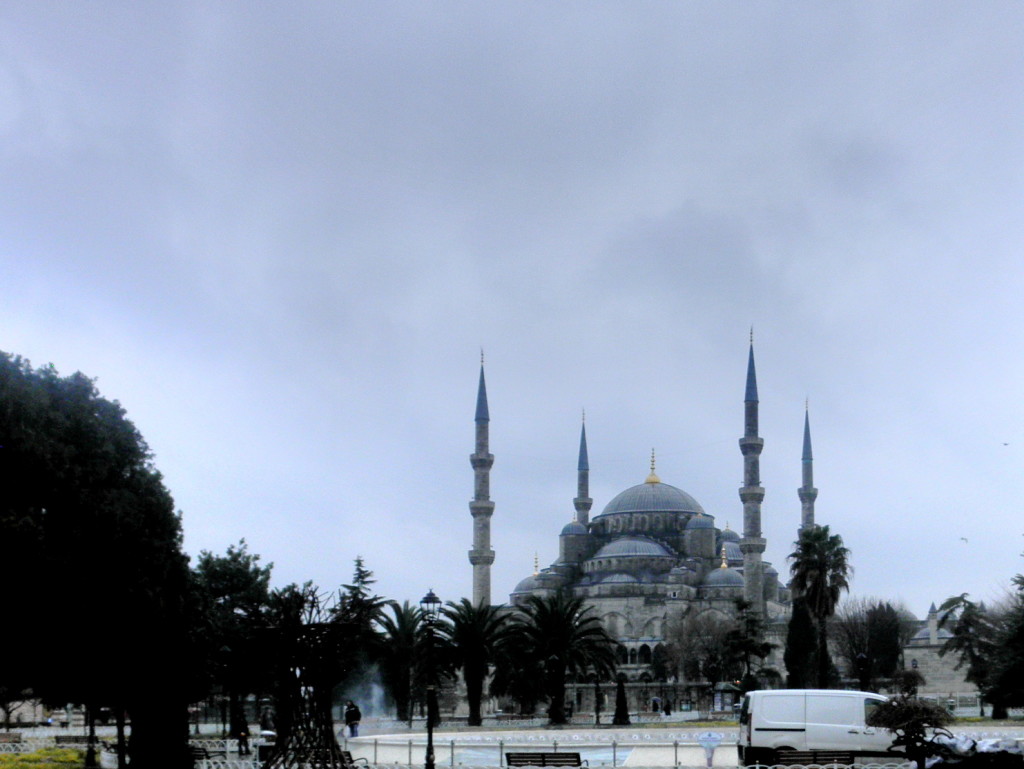
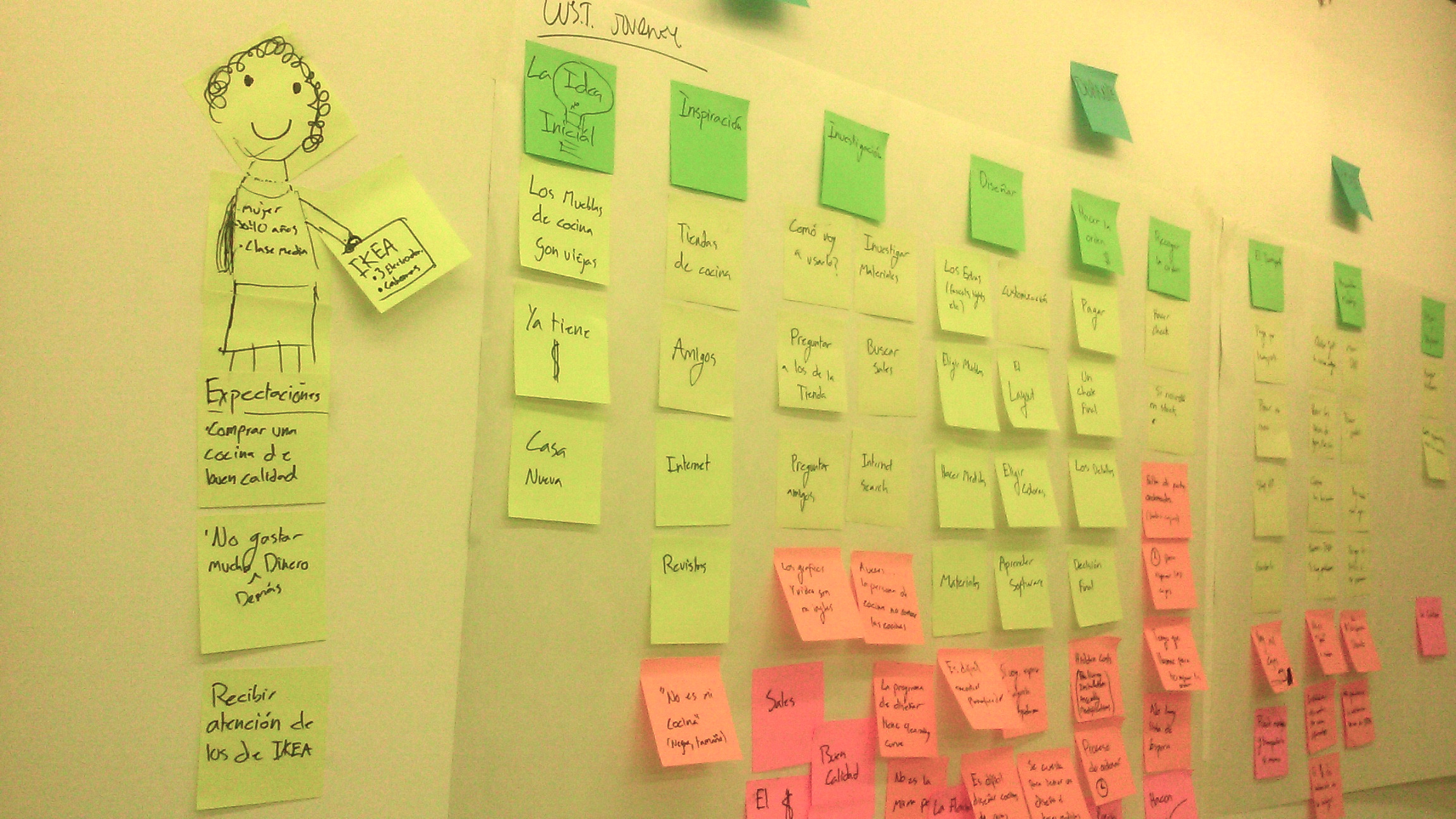
Charades
I have been playing an ongoing game of charades for two weeks.
I made the decision to move to Madrid and work with Soulsight for my second term with Experience institute. Not only is the work new and exciting, but it’s also in Spanish. … and my rusty Spanish is Mexican-Spanish, not Spain-Spanish.
It’s not that my co-workers and I don’t understand one another; I’ve been able to keep up with and participate in the majority of our discussions. But every once in a while I will be riding the wave of conversation and then BAM! I am left swimming without my surfboard. I know what the culprit is too: Los dichos.
Los dichos, or sayings, are the phrases, slang, or words we use that do not directly translate into another language. I know a bunch from Mexico – vato (dude), dime con quien andas y te diré quien eres (birds of a feather flock together) – but zero from Spain. Not to mention that all of the palabrotas (curse words) I know from Mexico don’t have the same negative meaning here and are used everyday. It took me a week before I would say, “¿me coja una soda?” (get me a soda). And that’s just the tip of the iceberg… (an american dicho).
Last week I translated a proposal for a company that makes catheters (I learned a bunch of new words during this one!). Things were going well until I got to a certain phrase: “las palancas de inspiración.” I understood the direct translation. Palancas – lever, inspiración – inspiration, but “levers of inspiration” didn’t make sense in English. I understood the sentido (meaning) of the dicho – the exchange of energy to lift or move something – but there wasn’t a direct translation to English. I tried motivation, tools, leveraging, and nothing seemed to fit. At another point I was faced with entender (to understand) and comprender (to understand). I understood these words to be interchangeable. That’s why I was stumped when they were listed right after each other in the steps of a process: 1) entender 2) comprender. It turns out that entender is to understand something, while comprender is to really “get” it.
And that’s the best translation I can come up with so far.
I accept that there are millions of words I do not know. When my partner in the project, Álvaro, and I get to a point where we can’t explain something to each other in either Spanish or English, we bust out pen and paper and start sketching or act it out so that the other can guess the meaning. Todays spontaneous game of pictionary and charades included my co-worker explaining a surgical procedure and me describing when we moved my house down the street. (Yes, we moved the actual house…) Those are things you don’t learn to say in Spanish class. Sure I can ask Dondé está la biblioteca or tengo que usar el baño, but those aren’t exactly useful phrases when I’m trying to negotiate deals and create new processes to sell kitchens in IKEA.
Language is a fickle thing. We use words, sentences and phrases to transfer meaning. The thought-stuff that is inside our heads that we code into words and spit out to be received and decoded into more thought-stuff in a different brain. It’s complicated and we don’t all do it the same way. That is why we have “miscommunication” or why we have a thought that we can’t put into words. It is also why we can convey something deep that no dictionary could explain, with something as simple as un abrazo. Meaning to meaning. Though I might not always entender everything that my colegas at Soulsight say, I do comprender that they care and respect me. From the moment I walked through the door I felt like I was part of their team.
Often we see language as the biggest barrier between people. Wars have been fought simply because people couldn’t communicate. And while it is true that sometimes complex topics like politics, legal discrepancies, or even catheters require a deep understanding of the language, the most complex feelings can be told without exchanging a single word. Sometimes we get so caught up in the dichos and details of life that we forget that we are all human, and that we share “meanings,” even if we don’t share a native tongue.
Sometimes, we just have to play charades and act it out.
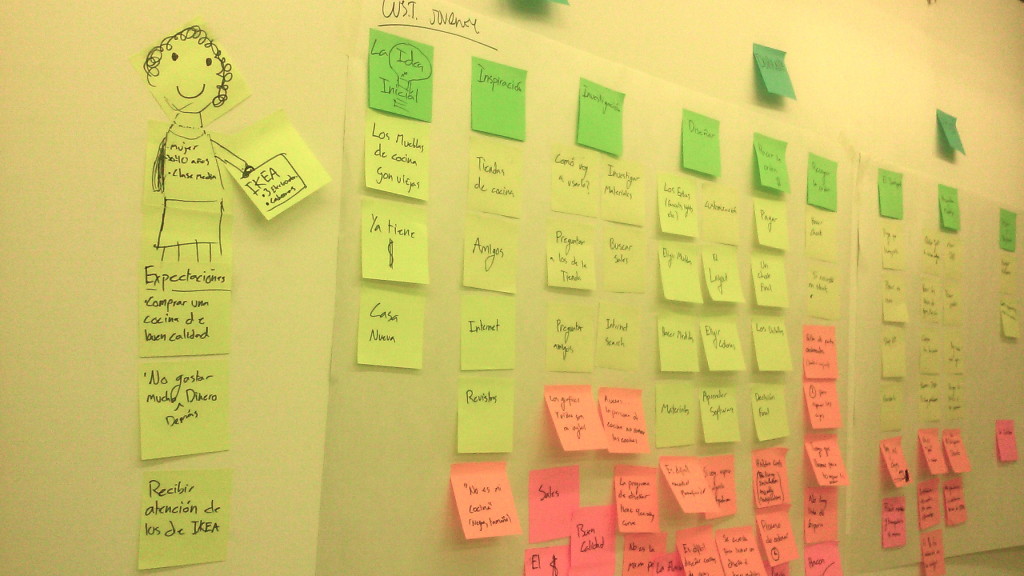
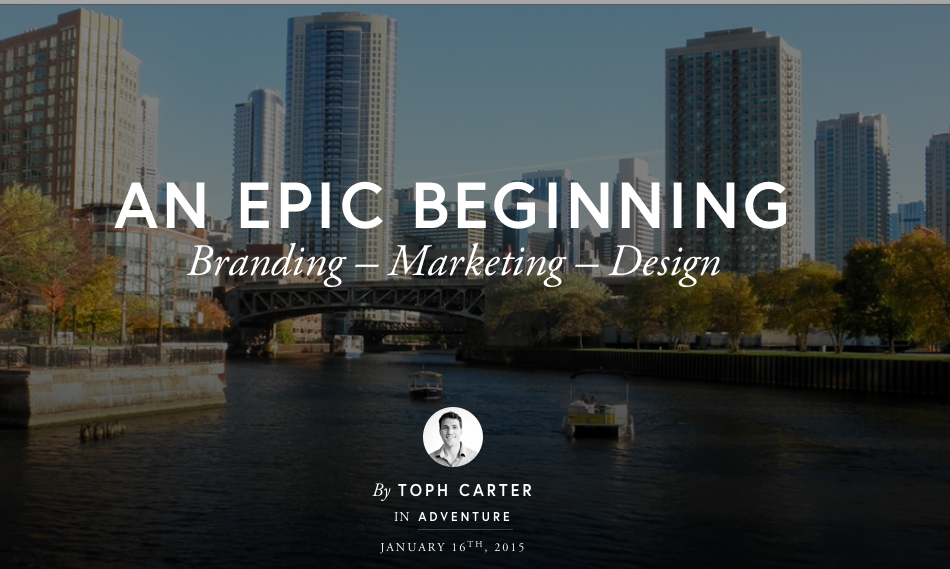
An EPIC Beginning
Click here to read more of my time with EPIC
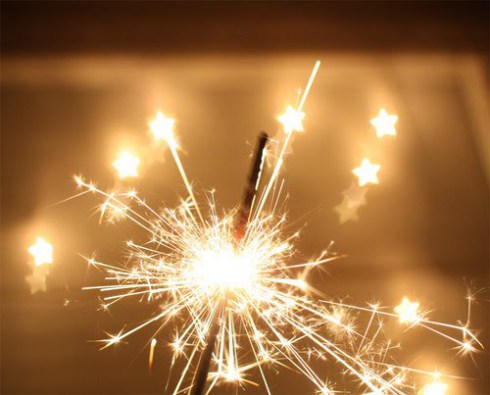
9 Ways to Fail at Goal Setting
Tonight is the last night of 2014. That means New Year’s Resolutions.
Goals are powerful. They can extend our vision and move us closer to our potential. They make it easier to create plans and to prioritize our lives so that we can accomplish what we set out to do. They can help us realize that the seemingly impossible is achievable when we put our whole force towards realizing our goals.
Even though I have seen the powerful potential that goals have, I am THE WORST at setting New Year’s Resolutions. This year I am resolving to do better (terrible pun). To help me – and you – make better goals that are achievable, I’ve compiled the following list of things I have learned not to do.
1. Make vague and immeasurable goals like: Be Healthy, Be a better friend, Do the things I love.
Instead make SMART goals
S – Specific
M – Measurable
A – Attainable
R – Relevant
T – Time-bound
Example: Walk 20 minutes every day and do a 5k in March, Go to lunch with a friend every Thursday, or audition for a play every other month.
2. Set TONS of goals.
Don’t set a million goals, instead focus on 3 or 4 things that you really want to work on. When you focus your energy and brainpower in this way, you can get a lot more accomplished. It is also less overwhelming than trying to change your whole life at once.
3. Make goals that other people want you to make.
Make sure that it is YOUR goal. If the goal is something that you make for another person, it won’t be high on your priority list. Don’t make goals for other people. Don’t make a decision to exercise and eat healthy because society says you should. Do it for you, because you want to feel better and take control of your life.
4. Focus only on the big stuff.
Break down larger goals into smaller chunks that are more digestible. If you want to run a marathon in 2015, make a plan how much you are going to run each week to get you there.
5. Think about your goals on New Year’s Eve… and that’s it.
Review your progress regularly. I like to take a look at my goals each Sunday and see how I am doing and what I can do during the week to realize my goals.
6. Use your AMAZING memory.
Write it down. All the time. Put it somewhere where you can see it and be reminded on a regular basis. A thought is a good intention, something written on a stickie on your mirror becomes a plan.
7. Trust that the good vibes from accomplishing a goal will be enough motivation to achieve it.
Reward yourself. Have a specific reward assigned to achieving a goal. I had a friend who wanted a new phone and decided that they could get it once they payed off their credit card. Rewards can be very motivating.
8. Do it yourself.
Share your goals with someone close. Ideally, find someone with a similar goal who can be your accountability buddy. It’s easier when you don’t have to do something alone.
9. Hate yourself when you don’t accomplish a goal.
Realize that if you don’t achieve your goal you are not a failure. If you learn and are doing better, than you are on the right path. Don’t abuse yourself or hate yourself when you have to reframe or adapt your goals.
I will make better resolutions and see what I can accomplish during 2015.
Let’s not suck at goal-writing this year!
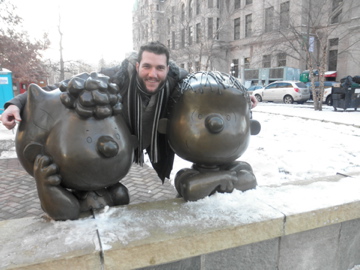
Zaksgiving part 2 – Minneapolis and St. Paul
The plan after Thanksgiving was to drive to the Twin Cities and spend the next two days getting the VIP tour of the area, but we were having too much fun in Geneva.
We decided to stay one more day. Zak’s cousin, Dusty, took us shooting on the family farm. Olenka, our Texan, had NEVER shot a gun and It had been eons since I had. It was a blast! There is something exhilarating about shooting a gun in sub-arctic weather. It makes you feel alive!
Afterour fingers were too frozen to pull a trigger, we got a tour of the farm. Olenka fell in love with a John Deere tractor.
When we got home from the farm we started playing Wizard. This game has you try to correctly guess the number of hands you will win and then scores you according to your accuracy. The competition was fierce, but I brought my game-face and won. After several hours of play, we switched to pool – where I was schooled.
The next morning we woke up early and headed to St. Paul and Minneapolis. These “twin cities” are built on either side of the Mississippi. What beautiful cities! The stone architecture reminded me of some cities in Europe.
We started in St. Paul making our first stop at Nina’s Cafe. I had a delicious tea and took a picture for Kristina. It was a block from the magnificent St. Paul’s cathedral. A HUGE church, that reminded me of the other St. Paul’s in Vatican City.
St. Paul and Minneapolis are the home of Charles Schulz of Peanuts fame, so I had to get a shot with Linus and Lucy.
We toured two Christmas markets and then ended up in an Irish Pub complete with a fireplace and board games. We played games, laughed, drank, and ate. It was lovely.
The next morning we climbed in the car and headed back to Chicago.
I love seeing these little pockets of America. There is character in every little town and an attitude in each city of this country. Take a chance and go explore.

Zaksgiving part 1
Normally on Thanksgiving my family packs up the car and travels two hours south to Salt Lake City to Hogle Zoo. We watch the animals tear through paper mache turkeys to get a special treat. The first year we went, no one was there – who goes to the zoo on Thanksgiving? It was a special time where we got to see the animals up close, they don’t miss out on food! (something that we humans haven’t evolved from yet..). Then we go home and eat a delicious turkey filled meal.
Instead of going to the zoo this Thanksgiving, I am driving somewhere else, Minnesota. My friend Zak invited any of us Ei-rs who were not going home for the holiday to come to his home in Minnesota to enjoy a traditional midwestern Thanksgiving. Olenka and I took the bate and accompanied Zak and his roommate Sam on the adventure – lovingly deemed #Zaksgiving
After 7 hours of driving we arrived in Geneva, MN. It was snowy, icy and dark. The little town was quiet as we drove through the one-and-only stop-light. We were welcomed by Zak’s parents with open arms and we headed downstairs to get some shut-eye before the anticipated holiday feast. I slept underneath this delightful duck/antler hybrid that looked like a dragon from underneath.
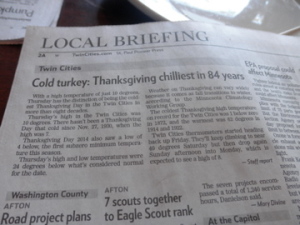 Thanksgiving morning we woke to a BITTER cold! It was -14º, and not expected to get much warmer. The paper said that it was the coldest it had been on Thanksgiving in 84 years!
Thanksgiving morning we woke to a BITTER cold! It was -14º, and not expected to get much warmer. The paper said that it was the coldest it had been on Thanksgiving in 84 years!
It didn’t deter us. We grabbed the turkey and some deserts and bravely walked into the frost. We walked/skated all the way to Zak’s aunt’s house (an entire 4 houses down! I love little towns).
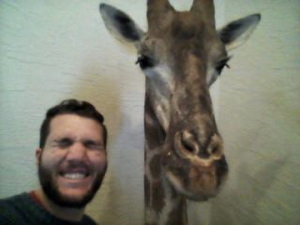
We were welcomed inside and smelt the warmth of a Thanksgiving feast. After meeting cousins, aunts and friends we made our way into the living room where tables and chairs were set up amid what I can only describe as a soirée safari . I got my Thanksgiving zoo experience after all! I sat next to a giraffe and across from a herd of wildebeest.
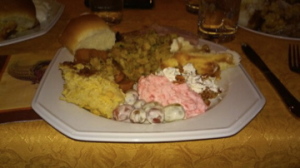 Dinner was delightful with a full spread –– the classics: turkey, ham, stuffing, yams; new favorites: a pineapple pretzel deliciousness and a Minnesota staple, grape salad; plus a surprise, jello with carrots (apparently that is a thing outside of Utah too!). Everything was delicious and plentiful. The only surprise (besides the aforementioned jello) was that there were only 3 pies for 30 people. In my house, where there are typically 8 pies for 7 people, we would have had major chaos. I thought there might be a competition to see who would actually get pie. To my surprise there wasn’t, and only 1 pie was eaten. I still do not know how this is possible – my only explanation is a miracle similar to the loaves and the fishes in the bible…
Dinner was delightful with a full spread –– the classics: turkey, ham, stuffing, yams; new favorites: a pineapple pretzel deliciousness and a Minnesota staple, grape salad; plus a surprise, jello with carrots (apparently that is a thing outside of Utah too!). Everything was delicious and plentiful. The only surprise (besides the aforementioned jello) was that there were only 3 pies for 30 people. In my house, where there are typically 8 pies for 7 people, we would have had major chaos. I thought there might be a competition to see who would actually get pie. To my surprise there wasn’t, and only 1 pie was eaten. I still do not know how this is possible – my only explanation is a miracle similar to the loaves and the fishes in the bible…
After dinner I was introduced to a new tradition –– a Thanksgiving craft. The Tracy’s pulled out canvases, paint, and brushes and let us free. There were some examples but mostly laughs and creative energy. I painted a penguin Christmas (I can honestly only draw birds).
After a few hours we headed back to Zak’s. We played a card game, Wizard, pool and ping pong. It was a marvelous time
I am so grateful for the hospitality and kindness of the Tracy family. There are good people everywhere!
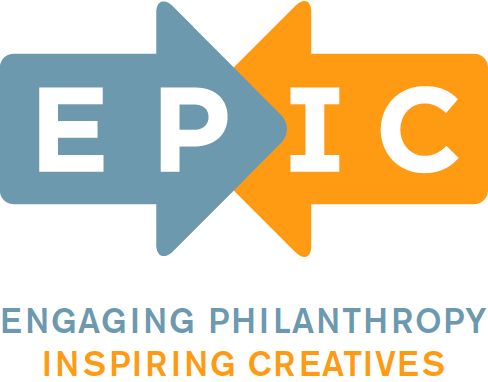
I AM EPIC!
Rubbing shoulders with top-creatives and making a difference in the community simultaneously? Sounds like a win!
One of my goals for this year is learning the role that creativity plays in the workplace. I want to see how creative people (or people in creative roles) enhance their work environment and business profitability. Creativity exists in several different environments. Because of this, I want to learn each semester at a different size organization: ideally, a nonprofit, a small company, and a larger corporation.
The first was my non-profit semester. I had applied and spoken to several different organizations before I found out about EPIC (cue trumpet herald)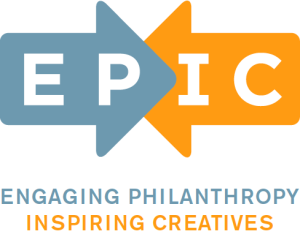
EPIC is INCREDIBLE. OH MY GOODNESS GRACIOUS. I am one lucky dog!
(now that is out of my system..)
So a little about EPIC.
EPIC is a 501(c)(3) that inspires and offers a platform for creative professionals to have social impact in Chicago (and now Minneapolis!). EPIC recruits and matches volunteers (e.g. marketers, designers, storytellers) to collaborate with non-profit organizations–who otherwise would not have access to this caliber of talent–to strengthen their mission through more impactful print and web design and branding strategy. During an eight week creative rally, each team creates programs and materials – on a strictly pro bono basis – that their nonprofit client will use to more effectively engage and impact the lives of those they serve. With their powers combined, they make a bigger impact on the world than either could alone.
This year EPIC has helped Culinary Care, Topbox Foods, Honeycomb Project, Illinois Humanities Council, Genesys Works, Twist Out Cancer, and Interfaith House, working to tell their stories and ultimately change the lives of more people.
So what am I doing here?
I am studying how creativity is used to capture the essence (or brand) of an organization in order to tell a provocative story and augment their ability to help people. By increasing this community involvement/outreach the NPO can help more people with clearer strategy, better marketing tools and a focused message.
I’m doing what EPIC does, but for EPIC (talk about meta). We are focused on telling EPIC’s story. My partner, Chevy, and I have been interviewing each creative director and NP client for the seven rallies completed this year. We have been interviewing for two weeks and have already visited the offices of Edelman, Simple Truth, Oglivy, Genesys Works, shared a phone call with the founder of Culinary Care, with one of the Kennedy’s (of JFK fame…), and met with the founder and inspiration behind Twist Out Cancer (she is AMAZING).
It’s been a busy two weeks!
On top of that, we are planning an EPIC event to highlight all of this incredible work. We have been scouring the city of Chicago for a location that is both economical and enhances the absolutely mind-blowing work that has been done this year. It has been a challenge, but not without its perks. I have visited building after building here in Chicago – taking advantage of Open House Chicago in the process. I’ve stepped in everything from the library on the 44th floor of a skyscraper to a coworking spaces nestled behind a church in an industrial park. We’ve finally decided on a space and should be signing a contract Today! I don’t want to spoil the surprise, so I’ll talk about it in a later post.
What have I learned?
Where to start?
- In order to become better at branding and to highlight the character of EPIC, I attended Eric Staple’s masterclass (there’s my musician coming out) .. workshop at WorkShop. We spoke at length about what makes strong brands and how to improve our own personal branding. I learned so much from it that it deserves it’s own blogpost.
- I’ve been devouring the Seth Godin’s book All Marketers are liars tell stories. It explains how marketing is not advertising, but is the spread of an idea. I’m only a quarter of the way through it, and my mind is already blown.
- I decided that I want to learn more about Human Centered Design, so I am taking a class through IDEO and ACUMEN. We are focusing on how to help inspire more social entrepreneurship among young people.
- I’ve learned that it is good to be a bad-ass. Taking risks, asking for favors, and showing up to bat are critical in all aspects of life.
- I’ve learned how to write a professional contract that is fair to the parties involved.
- I have learned that people will be rude, and will “rip your dress” not to mention any names, TAWANDA.
- I’ve seen that EVERYTHING is negotiable. I have listened and participated in several of these negotiations as we barter for spaces, goods and services.
- I have also learned that booze is expensive and am grateful for the economicalness of my decision not to drink.
- I’ve learned that creativity is not exclusive, anybody can be creative. What stifles our creativity is the need to be perfect.
- I have learned that walking 3 miles in the sun is still easier than walking half a mile in the wind/sleet/snow.
- I’ve learned the importance of good shoes, and a wind jacket.
- I’ve learned that soup is good for the soul, especially with good friends and giving hosts.
And I’m only a month in! I’m looking forward to November and the lessons I’ll learn as I continue to grow.
[contact-form][contact-field label=’Name’ type=’name’ required=’1’/][contact-field label=’Email’ type=’email’ required=’1’/][contact-field label=’Website’ type=’url’/][contact-field label=’Comment’ type=’textarea’ required=’1’/][/contact-form]
Train Across the Midwest – the beginning of an adventure
Your sound turned down?
Sometimes you have to do something crazy.
1400 Miles.
6 States: Utah – Colorado – Kansas – Nebraska – Iowa – Illinois.
Why do people go on adventures? Since cavemen could stand on two legs, they have been wandering into each others’ caves.
Sometimes our journeys have a practical purpose. Other times we go where the wind takes us. In either case, we grow through these wanderings.
“Not all those who wander are lost.”
― J.R.R. Tolkien, The Fellowship of the Ring
My journey began at 1:00 AM in Logan, Utah. I made my way to Salt Lake City and caught the 3:30 AM train headed to Chicago. I went over the river and through the woods—up the mountain down the valley through canyons and cornfields—snaking my way across the Midwest.
Utah – Colorado – Kansas – Nebraska – Iowa – Illinois.
36 hours. 6 states. 1400 Miles.
The sunrise woke me up at 6:00 AM. The colors blossomed over the fall canyon walls: blooming roses shed from a fiery pollen core.
My seat pal behind me, Launa (traveling from Seattle to Boston), kept giving me treats and snacks.
I marveled at the beauty of the springs of Colorado and was humbled by my first view of the vast plains of Nebraska and Kansas. Miles and miles of cornfield as far as the eye could see.
I found myself thinking through the long ride, “Why do people go new places?”
Is it to meet new people? Is it to see things we have never seen before?
Maybe…but I think it is so we can learn more about ourselves. When we are away from the comfort of home, we sense our true character, without our family, friends, or peers to influence us.
When we are away, we become stronger as we face challenges and learn to overcome them.
We learn to trust others, as we knowingly put our lives into their hands.
We learn to trust our instinct as we turn onto paths we’ve never before walked.
We break routine and we shatter established patterns of thought.
“Travel is fatal to prejudice, bigotry, and narrow-mindedness, and many of our people need it sorely on these accounts. Broad, wholesome, charitable views of men and things cannot be acquired by vegetating in one little corner of the earth all one’s lifetime.”
― Mark Twain, Mark Twain: The Innocents Abroad/Roughing It
My journey is just beginning. This adventure has brought me to Chicago. I’m here to learn. I’m here to grow.
Where will you go on your next adventure? Who will you be when you come back?
Practice
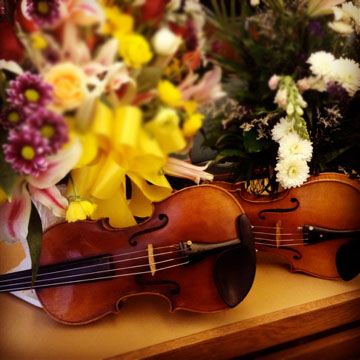 When I was four years old, I had a red toy violin. It was a brilliantly designed toy that would play familiar melodies from Twinkle-TwinkleLittle Star to Old McDonald had a Farm (E-I-E-I…) according to the speed of the plastic yellow bow moving across the “strings.” I would play for hours, not even stopping when the bow got lost. Instead, I improvised with a pencil or my finger.
When I was four years old, I had a red toy violin. It was a brilliantly designed toy that would play familiar melodies from Twinkle-TwinkleLittle Star to Old McDonald had a Farm (E-I-E-I…) according to the speed of the plastic yellow bow moving across the “strings.” I would play for hours, not even stopping when the bow got lost. Instead, I improvised with a pencil or my finger.
Shortly after that, I wanted to play a real violin. I begged my parents to let me take violin lessons to no avail. They were both pianists and thought that I would do better if I learned to read music and play the piano for a year or two before I began violin. Reluctantly, I agreed and began playing Hot Cross Buns and Peter Piper on the piano. When my sister started orchestra, I threw a FIT!
“It’s not fair!” I cried “She doesn’t even want to play the violin and she gets to. I’ve wanted to play forever and you aren’t letting me! How come everytime I want to do something she gets to do it first?!” You get the picture. My persistence won over my parents and they found me a little violin—one with a real wood bow and silver strings—to match my small six-year-old frame.
Crystal was the first of many violin teachers. She patiently taught me the basics of holding the violin, the importance of rhythm, and listening to the notes to make sure they were in tune. It was difficult, but I enjoyed the learning and structure. Under her tutelage, I finished the first book of the Suzuki method and was on my way to becoming a violinist. Since Crystal, I have had a few other teachers: Law, Monday, Mcalister, Mindy, Roxanne, Hen, Severinson and others helped me to learn and grow as a violinist. I learned shifting, vibrato, harmonics, but most importantly the value of practice.
Practice was not always glorious or exhilarating. It often involved tediously slow repetitions of used to be the key to a well-paying and benefitted job. Today that key has changed. What difficult phrases or moving my hand back and forth again and again until I could perfectly jump from one note to another. Practice was stumbling through a new piece over and over until, eventually, I could express myself through the song of another.
It was through doing and trying that actual learning occurred. It would be impossible to learn the violin only by watching others or reading books about theory. You have to pick up the instrument and play. I am reminded of Harold Hill in Meredith Willson’s Music Man where he employs the “think method” for students to learn a new instrument. He explains that all you have to do is think about the notes and they will come. To me it seems like this “think method” has permeated into our educational system. Students know a lot about theory, they know equations, rules, and statistics—but they lack experience.
College graduates face a different world than that of their parents. In a 2013 survey, over 40% of recent college graduates are unemployed and 16% are in part time positions. A degree employers are looking for is experience, skill, and potential value a candidate can offer. These cannot be taught in a traditional educational setting, by reading books and attending lectures, but need to be learned through doing. Just as practicing the violin is mandatory for a proficient violinist, students need experience to be competent professionals in the workplace. Experience gained through volunteering, internships, networking, and innovation empowers individuals to contribute maximum value to society.
So that is why I have joined Experience Institute. To learn by doing. I know I won’t be fantastic in the beginning and I’ll likely fall flat on my face the first time I try a new skill or step into a unknown arena—but I won’t give up. I’ll keep trying and struggling until I slowly become better. Through perseverance, stubbornness, and grit, I will shape my character and become a more complete and effective tool to help others.
